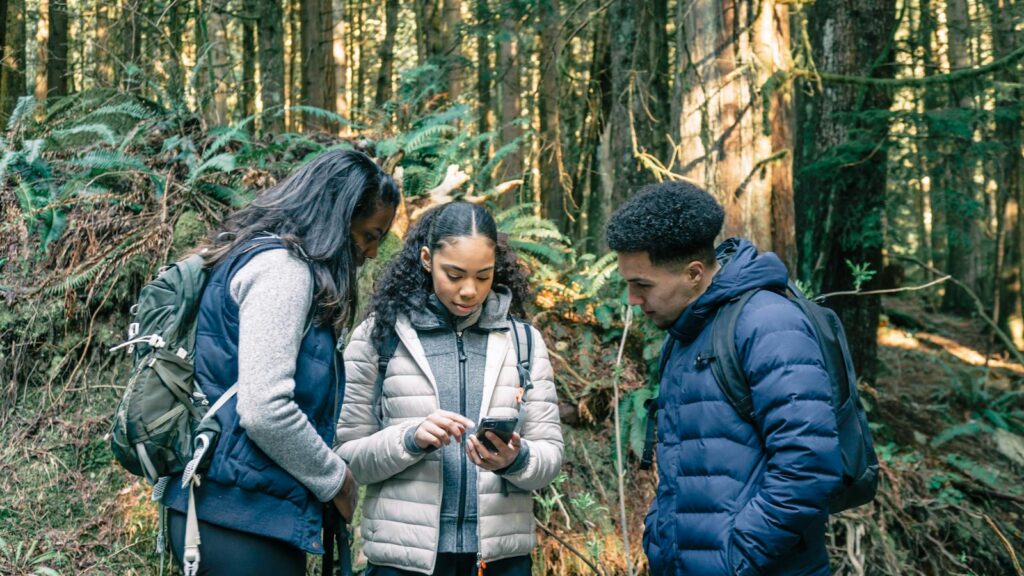The way we navigate trails while riding has evolved dramatically over the years – from paper maps tucked into saddlebags to sophisticated GPS devices mounted on handlebars. Today, we stand at the cusp of another revolutionary shift in trail navigation technology. Smart helmets with built-in displays, augmented reality overlays, AI-powered route suggestions, and interconnected riding communities are transforming how we experience trails on two wheels. Whether you’re a mountain biker traversing rugged terrain, a gravel enthusiast exploring backroads, or an urban cyclist navigating city paths, the future of trail navigation promises to make your rides safer, more immersive, and more connected than ever before. Let’s explore these emerging technologies and consider how they might reshape the landscape of trail riding in the coming years.
The Evolution of Trail Navigation: From Paper Maps to Digital Revolution

Trail navigation has undergone a remarkable transformation throughout history, beginning with rudimentary paper maps that required careful interpretation and manual orientation. In the early days of trail riding, cyclists and equestrians alike relied on physical maps, landmark recognition, and sometimes painted trail blazes to find their way through wilderness areas. The digital revolution brought the first significant shift with the introduction of GPS devices specifically designed for outdoor recreation in the early 2000s, allowing riders to track their position with unprecedented accuracy. Smartphones later democratized access to digital navigation, with apps like Trailforks, Strava, and AllTrails becoming essential companions for millions of outdoor enthusiasts. This evolution reflects our enduring desire to explore with confidence, combined with technological innovation that continues to redefine what’s possible on the trail.
Smart Helmets: Navigation at Eye Level

Smart helmets represent one of the most promising developments in the future of trail navigation, integrating heads-up display technology directly into protective gear. Companies like LIVALL, Lumos, and Sena are pioneering helmets that project navigational data into the rider’s field of vision, eliminating the need to look down at a handlebar-mounted device. These helmets typically connect to smartphones via Bluetooth, translating turn-by-turn directions into visual cues that appear in the rider’s peripheral vision. The safety implications are significant—riders can maintain awareness of the trail ahead while simultaneously receiving navigational guidance, reducing the risk of obstacles or hazards going unnoticed. Advanced models incorporate voice commands, allowing riders to request alternative routes or nearby facilities without removing their hands from the handlebars, truly representing hands-free navigation for the trail rider of tomorrow.
Augmented Reality: Overlaying Digital Information on the Physical World

Augmented reality (AR) is poised to transform trail navigation by superimposing digital information directly onto the rider’s view of the physical environment. Unlike traditional GPS displays that require interpretation, AR systems can highlight the actual trail ahead with virtual markers, directional arrows, and distance indicators that appear to exist in the real world. Companies like Everysight with their Raptor smart glasses are pioneering this technology for cyclists, creating systems that can identify and mark hazards, indicate optimal lines through technical sections, and even display elevation profiles of upcoming terrain. The immersive nature of AR navigation reduces cognitive load by eliminating the mental translation between map and terrain, allowing riders to focus more on technique and enjoyment. As AR technology becomes more refined and affordable, we can expect these systems to become increasingly commonplace on trails worldwide, fundamentally changing how riders perceive and interact with the environment.
AI-Powered Route Recommendations: Personalized Trail Experiences

Artificial intelligence is revolutionizing trail navigation by offering highly personalized route recommendations based on a rider’s preferences, ability level, and current conditions. Modern AI systems can analyze thousands of trail attributes—including difficulty, terrain type, scenery, traffic patterns, and seasonal conditions—to suggest routes that precisely match what a rider is looking for on any given day. These intelligent systems learn from rider feedback, gradually building sophisticated preference profiles that understand, for instance, that a mountain biker might prefer technical descents but moderate climbs, or that a gravel rider might prioritize scenic vistas over fast segments. Companies like Komoot and Trailforks are already implementing machine learning algorithms that can recommend routes based on time available, fitness level, and previous riding history. The future promises even more sophisticated AI that can adapt recommendations in real-time based on weather changes, trail conditions reported by other users, or even a rider’s biometric data indicating fatigue levels.
Wearable Technology: Beyond the Smartphone

Wearable technology is creating new possibilities for trail navigation that extend beyond the limitations of smartphone-based systems. Advanced smartwatches from brands like Garmin, Suunto, and Apple now offer sophisticated GPS capabilities with detailed mapping, barometric altimeters for precise elevation tracking, and battery life sufficient for multi-day adventures. These devices can provide haptic feedback—gentle vibrations indicating upcoming turns or hazards—allowing riders to navigate without visual distraction. Emerging technologies include smart gloves with integrated LED indicators that illuminate to show direction, and lightweight bone-conduction audio systems that deliver turn directions without blocking environmental sounds crucial for trail awareness. Some companies are even developing smart apparel with embedded flexible electronics that can provide subtle navigational cues through gentle pressure or localized vibration, guiding riders while maintaining a completely natural riding experience free from visual displays.
Connectivity and Community: Social Navigation Networks

The future of trail navigation is increasingly interconnected, with social features transforming solitary navigation tools into community platforms that enhance the riding experience. Modern trail apps allow riders to share real-time locations with friends, facilitating group rides even when participants begin from different starting points or ride at different paces. Trail condition reporting has evolved into sophisticated crowdsourced information networks, where riders can flag obstacles, report maintenance issues, or alert others to wildlife sightings, creating a dynamic, constantly updated trail awareness system. These platforms also enable community route building, where popular rides emerge organically through the collective wisdom of local riders rather than through official designations. The social dimension extends to performance as well, with virtual competitions and challenges creating engaging experiences that transform ordinary rides into opportunities for friendly competition or personal achievement, all facilitated by navigation technology that tracks and shares these experiences.
Energy Harvesting and Power Solutions: Keeping Navigation Alive

One of the critical challenges facing advanced trail navigation systems is power supply, especially on extended adventures where charging opportunities may be limited. Innovative energy harvesting technologies are emerging to address this need, including solar panels integrated into helmet designs or bike frames that can generate supplemental power during daylight rides. Kinetic energy recovery systems that convert the bike’s movement into usable electricity represent another promising approach, with some systems able to generate power from both the rotation of wheels and the compression of suspension components. Advanced battery technologies with higher energy densities are also transforming what’s possible, with some modern navigation devices now capable of recording GPS tracks for over 100 hours on a single charge. For bikepacking and multi-day adventures, portable power stations that can be charged from various sources—including solar panels, campsite power, or even stream-powered mini-turbines—are becoming increasingly compact and powerful, ensuring navigation systems remain operational throughout extended journeys.
Environmental Impact and Ethical Considerations

As trail navigation technology advances, important questions arise about its environmental impact and ethical implications for outdoor recreation. Digital navigation tools have undoubtedly helped concentrate traffic on established trails, potentially reducing off-trail damage, but they have also made remote areas more accessible, increasing visitation to previously low-traffic wilderness. Some land managers have expressed concern that real-time trail sharing might facilitate overcrowding at sensitive locations or during wildlife breeding seasons, raising questions about whether certain areas should be intentionally excluded from navigation databases. The manufacturing and eventual disposal of electronic navigation devices also creates environmental costs that must be weighed against their benefits, prompting some manufacturers to develop modular designs that allow for component upgrades rather than complete device replacement. There are also philosophical considerations about whether constant digital connectivity fundamentally changes the nature of wilderness experience, with some riders intentionally choosing to limit their use of navigation technology to preserve a sense of exploration and self-reliance in natural settings.
Voice-Activated Systems: Hands-Free Control

Voice-activated navigation systems represent a significant safety advancement for trail riders, allowing hands-free control of navigation functions without compromising control of the bike. Modern systems can respond to natural language commands like “find me a less technical route,” “how far to the next water source,” or “mark this location for future reference,” executing complex navigation tasks without requiring manual input. The technology is becoming increasingly sophisticated in filtering out wind noise and differentiating between conversation and actual commands, making it reliable even in outdoor environments. Some systems now incorporate contextual awareness, understanding that a request for “more flow” from a mountain biker likely refers to trail characteristics rather than hydration, demonstrating how these systems are becoming specifically tailored to the needs of trail riders. For international travelers, real-time translation capabilities are being integrated into premium navigation devices, allowing riders to receive directions and trail information in their preferred language regardless of where they’re riding.
Trail Difficulty Standardization and Dynamic Rating

The future of trail navigation includes more nuanced and responsive trail difficulty ratings that go beyond traditional static classifications. Advanced systems are beginning to incorporate dynamic difficulty ratings that account for current conditions, recognizing that the same trail can be substantially more challenging after rain or during seasonal changes. Machine learning algorithms can now analyze thousands of ride reports to create difficulty distributions rather than single ratings, helping riders understand whether a trail’s difficulty is consistent or contains isolated technical features that might be walkable. Some navigation platforms are introducing personalized difficulty ratings that calibrate to individual rider abilities based on their history with similar trails, providing recommendations that are truly matched to skill level. Standardization efforts across platforms are also gaining momentum, with initiatives to create universal difficulty metrics that remain consistent across different regions and riding disciplines, eliminating the confusion that can occur when switching between navigation systems or riding in unfamiliar locations.
Emergency Features and Safety Integration

Modern trail navigation systems increasingly incorporate sophisticated safety features that can prove lifesaving in emergency situations. Crash detection algorithms can identify sudden deceleration patterns consistent with accidents and automatically trigger location sharing with emergency contacts if the rider doesn’t respond to a prompt. Some systems include integrated satellite SOS functionality that can summon help even in areas without cellular coverage, transmitting precise coordinates to search and rescue services. Advanced navigation devices are beginning to incorporate biometric monitoring that can alert riders to signs of dehydration, heat exhaustion, or altitude sickness based on data from connected sensors, potentially preventing emergencies before they occur. The most sophisticated systems are developing predictive capabilities that can warn riders about upcoming hazardous conditions—such as weather changes, dangerous wildlife activity, or trail sections with high accident rates—creating a proactive safety layer that complements traditional reactive emergency features.
Accessibility and Adaptive Navigation for All Riders

The future of trail navigation technology is becoming increasingly inclusive, with specialized features designed to make outdoor adventures accessible to riders of all abilities. Navigation systems are being developed with adaptive interfaces for visually impaired riders, using audio cues and haptic feedback to communicate route information without requiring visual attention. For riders with mobility impairments using adaptive bikes or hand cycles, specialized routing algorithms can prioritize trails with appropriate width, surface stability, and manageable gradient changes, filtering out routes with obstacles like tight switchbacks or technical features that might be impassable. Some systems now include detailed accessibility information about trailhead facilities, noting the presence of accessible parking, restrooms, and mounting aids that make starting and ending rides easier for riders with disabilities. This focus on inclusive design represents an important evolution in navigation technology, recognizing that with the right information and tools, trail experiences can be made accessible to a much wider range of enthusiasts than previously possible.
conclusion

The future of trail navigation represents a fascinating convergence of technology and outdoor recreation, promising to transform how we experience and interact with trails. From smart helmets and augmented reality displays to AI-powered recommendations and community-based information sharing, these innovations offer exciting possibilities for safer, more accessible, and more engaging rides. However, as we embrace these technological advances, we must also consider their broader implications for environmental impact, wilderness experience, and the fundamental nature of outdoor adventure. The most successful navigation solutions will likely be those that enhance the riding experience without diminishing the connection to nature and sense of discovery that draws many to the trails in the first place. As these technologies continue to evolve, they have the potential to welcome more diverse participants to trail riding while helping preserve the trails themselves for future generations of riders.







